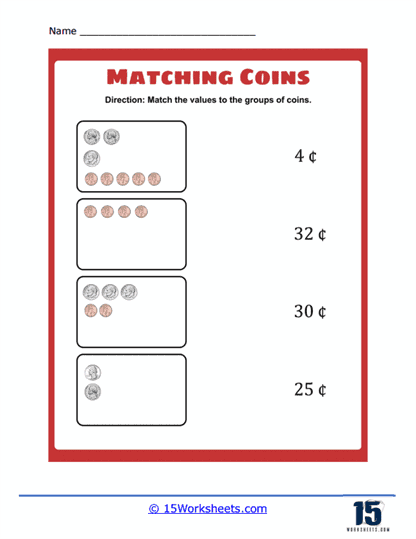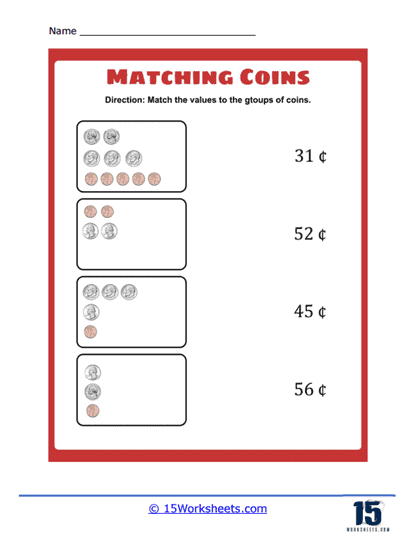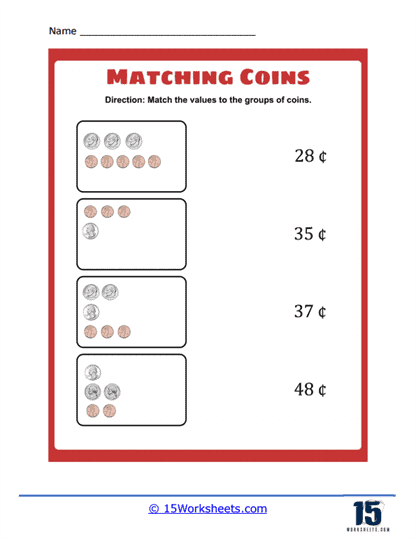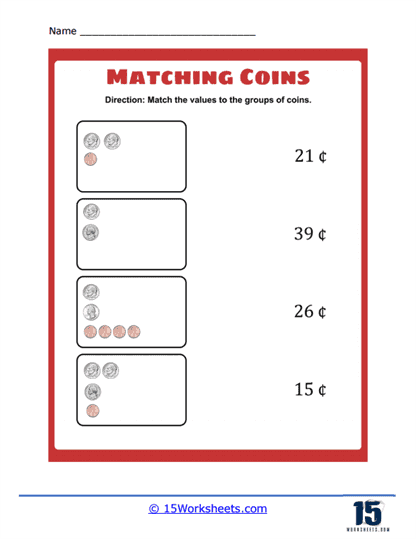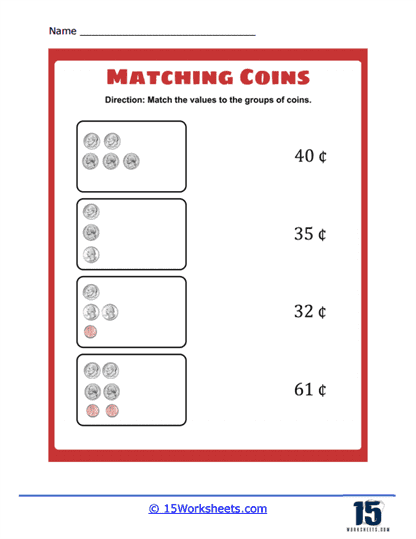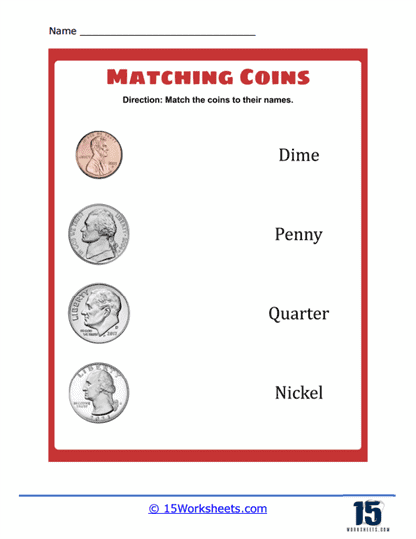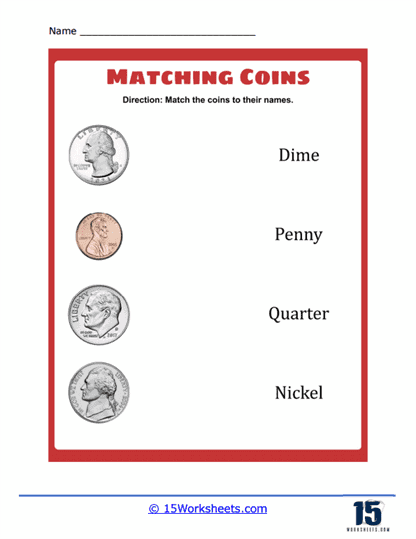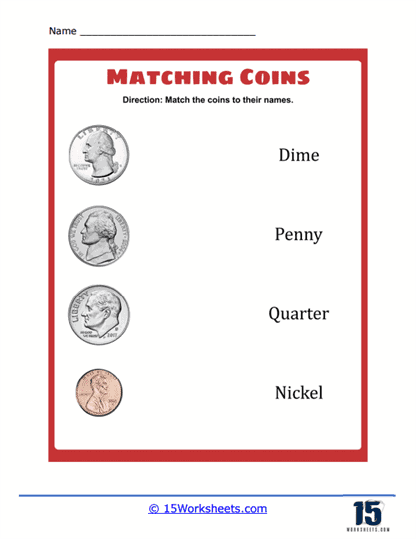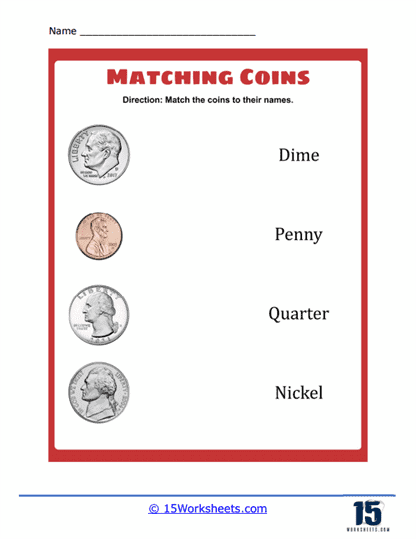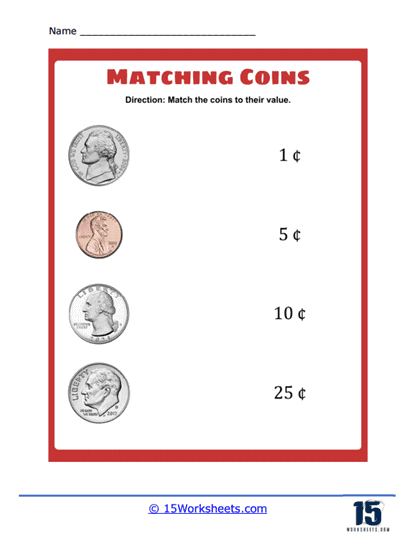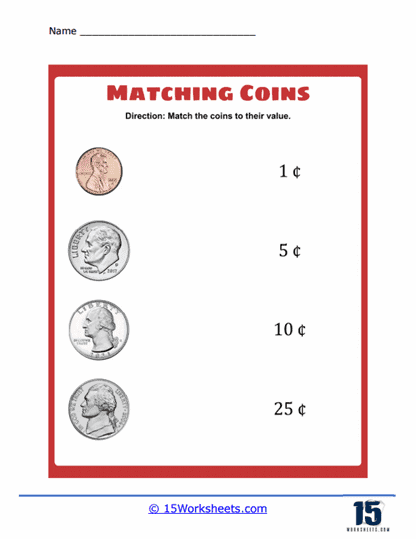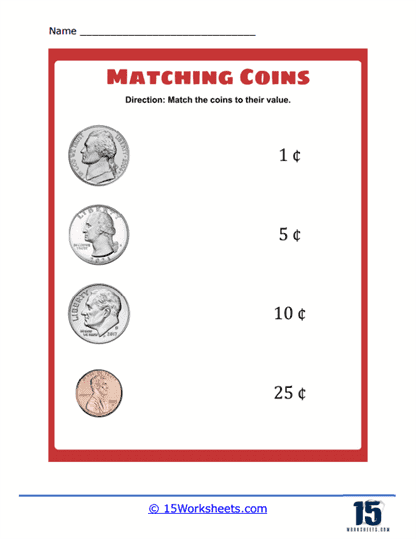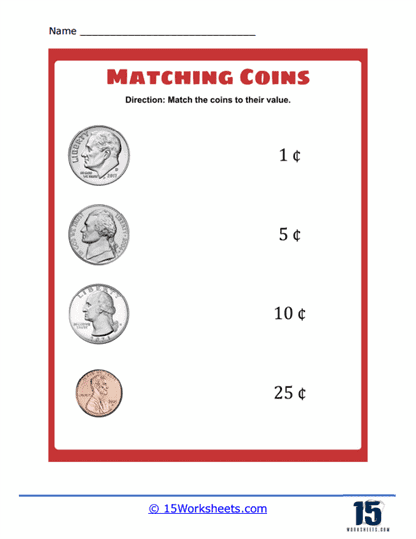Matching Coins Worksheets
About Our Matching Coins Worksheets
These worksheets will help students develop the ability to identify, count and calculate the value of coins. You will find a wide variety of coins of different denominations, such as pennies, nickels, dimes, and quarters. These worksheets can come in many different forms, such as fill-in-the-blank exercises, matching games, and puzzles. Some worksheets might ask children to count the total value of a given set of coins, while others might ask them to identify the coins needed to make a certain amount of money.
This is a practical skill that children can apply in their daily lives. It helps them handle money, make purchases, and understand the value of different coins, which are essential life skills. It introduces children to the concept of money and develops their financial literacy. They learn about the different denominations of coins, their worth, and how to calculate the total value of a group of coins.
Matching coins to their values enhances problem-solving skills. Children need to figure out how to combine coins to reach a specific value or how to make the correct change during transactions. It encourages critical thinking and logical reasoning. It also requires visual discrimination skills. Children learn to differentiate between different coin types based on their size, shape, and markings, which sharpens their observation and attention to detail.
A Look At Individual Worksheets
If you’ve ever fished around the bottom of your couch cushions looking for enough change to buy a soda and thought, “There has to be a better way,” then congratulations-you’re already halfway to mastering the noble art of Matching Coins. The worksheets are like financial boot camp for the K-2 crowd, minus the yelling and push-ups. The “Coin Match” worksheet kicks off the series like a polite introduction at a dinner party: “Hello, I’m a nickel. Do you know who I am?” Students begin by pairing coins with their proper names, faces, and values, like a dating app for U.S. currency. It’s the first step in turning your average six-year-old into a part-time cashier, full-time coin-sorting savant.
Once the young padawans of penny knowledge have matched coins to names, the worksheets raise the stakes. “Groups of Coins,” “Coin Sets,” and “Counting Coins” bring multiple coins into play-kind of like hosting a family reunion where everyone looks the same, but some are worth more than others. These worksheets train students to recognize groupings and add up values like little human calculators. If you’ve ever tried to count three nickels and two dimes without accidentally thinking they’re quarters, you’ll know this is no small feat. Kids have to combine visual recognition with arithmetic, like tiny accountants in training.
Things get even more cerebral with the “Finding Value,” “Large Coin Values,” and “Packs of Coins” worksheets. These require deeper thinking, like “What is the worth of this particular chaotic handful of coins?”-a question adults sometimes ask of their own lives. These sheets take your child’s math brain to the gym, with exercises in valuation, grouping, and the emotional turmoil of realizing that eight pennies still isn’t enough to buy anything fun. “Large Coin Values” even throws in some big-number shenanigans, for when you’re ready to go from lemonade stand to pocket-change tycoon.
But what is money, really, if not just… names and faces? Enter the philosophical section: “Name Each Coin,” “Do It Again,” and “Remember Names.” These are the existentialist worksheets. It’s not just about coins-it’s about memory, identity, and second chances. “Do It Again” sounds like a workout video or a bad life decision, but in this context, it’s a call to repetition: practice naming coins until it becomes as natural as breathing or asking your parents for ice cream money. And “Remember Names” could be a tribute to all the forgotten nickels of yesteryear-never forget.
We come to the capstone worksheets: “Coin Matters,” “Coin Values,” “What’s It Worth,” “Coins and Amounts,” and “Amount of Value.” These are the final exams of the Matching Coins curriculum. Here, students connect the abstract to the practical. They determine coin combinations to match amounts, assess relative values, and basically become monetary philosophers. “What’s It Worth?” they ask, in both a literal and a soul-searching sense. By this point, students can answer confidently: “That’s 47 cents, ma’am.” These sheets bring everything full circle: from identifying lonely pennies to understanding the true value of a well-organized pile of coins-and perhaps, by extension, a well-organized life.
How to Teach Kids to About Coins
Teaching kids to count coins is an essential skill that helps them develop a strong foundation in money management and real-world mathematics. Here are some steps and strategies to effectively teach kids to count coins:
Introduce Each Coin – Begin by introducing each type of coin (penny, nickel, dime, and quarter in the United States, for example), explaining their names, values, and physical characteristics. Help kids become familiar with the size, color, and markings on each coin.
Teach Coin Values – Clearly explain the value of each coin in terms of the base currency unit (e.g., cents in the United States). Emphasize the value differences between the coins and provide examples to help kids understand their relative worth.
Start with Single Coin Counting – Before moving on to mixed coins, have kids practice counting with single coin types. For example, ask them to count a specific number of dimes or nickels. This will help them become comfortable with each coin’s value and lay the groundwork for more complex counting tasks.
Use Visual Aids – Use visual aids like posters, charts, or flashcards that display coin images and their corresponding values. These aids can help kids better understand and remember coin values and relationships.
Teach Skip Counting – Teach kids to skip count by the values of each coin (e.g., counting by 5s for nickels, 10s for dimes, and 25s for quarters). This skill will make counting mixed coins much easier and more efficient.
Introduce Mixed Coin Counting – Once kids are comfortable with single coin counting and skip counting, introduce mixed coin counting. Start with simpler combinations of two coin types, and gradually increase the complexity by adding more coin types and larger amounts.
Practice with Real-world Scenarios – Create real-life situations for kids to practice counting coins, such as setting up a pretend store or playing games that involve purchasing items with a set budget. This will help them understand the practical applications of counting coins and develop their skills in a fun and engaging way.
Use Hands-on Activities – Encourage kids to physically handle coins while counting to help them develop a tactile understanding of coin values and relationships. This hands-on approach can also make learning more engaging and enjoyable.
Reinforce Learning with Games and Activities – Use games, puzzles, and other interactive activities to reinforce coin counting skills. Many online and printable resources are available to make learning fun and engaging.
Be Patient and Supportive – Learning to count coins can be challenging for some kids, so be patient and provide support and encouragement. Break down tasks into smaller steps and offer praise for progress and achievements.

